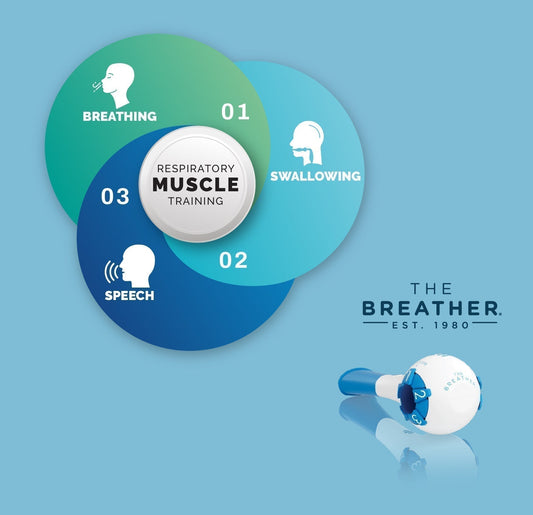Have you ever wondered why you still wake up tired or groggy even after a whole night’s sleep? While most people focus on sleep routines and bedtime habits, recent research reveals a surprising link between how we breathe, how well we sleep, and how stress-free we are during sleep, even in the absence of any medical conditions.
TIRERED OF BEING TIRED? It’s just you, your breath, and a better night’s sleep ahead.
This article will explore how strengthening your breathing muscles through Respiratory Muscle Training (RMT) can lead to improved sleep, a healthier heart, and better energy. All without medication, and yes, there’s science to back it up.


The modern sleep crisis: Why it matters
Sleep often takes a back seat to busy schedules, stress, and screen time in today's fast-paced world. Yet sleep isn’t just a way to rest; it’s one of the most important things your body does to heal, regulate, and recharge. When sleep quality suffers, everything from your mood to your immune system to your heart health can take a hit.
Surprisingly, even people who consider themselves healthy often struggle with poor sleep without realizing the long-term consequences. Research shows that sleep deprivation may raise blood pressure and resting heart rate, reduce mental focus, and even interfere with workout recovery and weight management.


What are common sleep disorders and their hidden health toll?
So now that we know sleep is non-negotiable for a healthy body and sharp mind, let’s go one step deeper. Millions of people walk around every day feeling tired or anxious, never knowing they are experiencing a mild but chronic sleep disorder. And it’s not a full-blown sleep apnea. There’s an entire spectrum of issues, from upper airway resistance to fragmented breathing during sleep, which usually fly under the radar.
According to the Centers for Disease Control and Prevention (CDC), every 1 in 3 adults in the U.S. does not get the recommended 7 hours of sleep per night [1]. American Heart Association says that 50-70 million Americans are living with a chronic or ongoing sleep disorder.
Worse? Many of the sleep issues go hand-in-hand with poor breathing habits, something we typically overlook.
And here is the kicker: you don’t have to snore loudly or wake up gasping to be affected by sleep problems. Even subtle breathing irregularities during sleep can reduce oxygen intake, spike your heart rate, and kick your nervous system into stress mode all night long.
What is heart rate variability, and why is it an important parameter?
When you sleep, your body goes into a recovery mode. If your heart can slightly speed up and slow down between beats (that’s what HRV is), your nervous system is relaxed, and your body is recovering efficiently. A higher HRV during sleep means you are recovering better, handling stress more easily, and waking up more refreshed.


Let’s draw an analogy for even better understanding. Think of your heart like a skilled driver. A high HRV means your driver can smoothly speed up and slow down based on road conditions. Conversely, low HRV is like a nervous or rigid driver who can’t adapt well. You can say the smoother the drive at night, the better you’ll feel in the morning.
Traditional solutions: What works and what doesn’t
By now, we know that disrupted breathing during sleep can quietly sabotage your rest and, in the long term, your health too. So what do people typically do when they’re struggling with poor sleep?
Most turn to the conventional solution, including sleeping pills, melatonin, or sleep hygiene hacks like cutting caffeine or keeping screens out of the bedroom. These strategies can be helpful in the short term, but they often miss the root of the problem. No amount of sleep hacks can fix a dysfunctional breathing pattern.
For people with diagnosed sleep apnea, the go-to treatment is the CPAP machine, which uses continuous air pressure to keep airways open at night. It’s effective, but it’s also bulky, noisy, and not always well-tolerated. Studies show that nearly 50% of CPAP users stop using the device within the first year [2].
And what about people who don’t qualify for a CPAP machine, but still wake up tired, foggy, and irritable? They often fall through the cracks and are given vague advice like “just relax more” or “try a lavender candle”, etc. These are nice in theory, but not very effective if your core issue is “inefficient breathing”.


This is where traditional fixes fall short and why researchers are shifting focus.
A new approach: Strengthening your breathing muscles
What if we could fix the problem at the source by strengthening the muscles that control our breath?
Instead of relying on machines or medications, the researchers are focusing on the mechanics of breathing and specifically, how training the respiratory muscles can improve both sleep and cardiovascular health.
RMT is a science-backed method that strengthens the diaphragm and other breathing muscles, much like strength training at the gym, but for your lungs.
And no, we’re not talking about deep breathing exercises or meditation apps. We’re talking about structured, progressive training using devices that create resistance as you inhale and exhale, making your breathing muscles work harder and strengthen over time.
Clinical trial overview: Examining RMT for sleep and heart health
A recent 2025 study put this idea to the test, and the results were even better than expected. In that research, 67 healthy, non-clinical participants (like you and me) were selected and divided into two groups. One group was asked to perform combined respiratory muscle training (cRMT) with the BREATHER FIT for five weeks, while the other group did not perform any training. The aim was to assess whether strengthening their breathing muscles could lead to better sleep quality and improved cardiovascular markers. [3]
Let’s break down what the study revealed and why it might be the most natural sleep upgrade you’ve never considered.
What the study found: Better breathing, better sleep, healthier heart
So, what happened when participants trained their breathing muscles using the BREATHER FIT?
After just 5 weeks of consistent RMT, researchers saw measurable improvements in the participants performing training.
Improved sleep duration
The researchers found that the sleep duration was improved in participants who were healthy but had poor sleep before the training period. That translates to more sleep, where your body does its most critical recovery work.


Improved Heart Rate Variability (HRV)
Healthy participants who performed RMT experienced a significant increase in HRV compared to the baseline. This significant improvement suggests that their autonomic nervous system became more balanced, i.e., shifting away from a stress-dominant sympathetic state toward a more relaxed and resilient parasympathetic state.
In practical terms, their hearts became more flexible and responsive, improving the body’s ability to recover from both physical and emotional stress. These benefits stem from the activation and strengthening of key breathing muscles, particularly the diaphragm.
When trained through RMT, breathing muscles send calming signals to the brain, triggering a powerful relaxation response. This ultimately results in more relaxed sleep and increased recovery.
No side effects
Other than the improvements mentioned above, there were no side effects, pills, or machines. Unlike medications or CPAP machines, RMT didn’t cause discomfort, noise, or disrupted sleep from the device; instead, the participants experienced steady and natural improvements.
How can I use the Breather FIT at home?
If you’re intrigued by the study findings, you’re not alone. The idea that you can train your way to better sleep with something as simple as a handheld device sounds almost too good to be true, but that’s the magic of RMT.
The BREATHER FIT is the very device used in the study we just explored. Designed by a respiratory therapist, it strengthens both your inspiratory and expiratory muscles.
Here’s how to get started:
Step 1: Begin with just 5–10 minutes per day
Most users start with two sets of 10 breaths, twice a day. That’s it, no sweat, no gym clothes required.
Step 2: Adjust the resistance gradually
As your breathing muscles get stronger, you can increase the resistance level, just like progressive overload in strength training.
Step 3: Stay consistent
Just like with any workout, results build over time. In the study, participants trained regularly for five weeks, and the improvements didn’t take long to appear.
And the best part? You don’t need a diagnosis, a prescription, or a doctor’s visit to get started. The BREATHRE FIT is safe, drug-free, and easy to use at home, whether you’re an athlete looking to optimize performance or simply someone tired of tossing and turning.


Imagine what it could do for you at home if it worked in a controlled study.
Next up — let’s tie it all together.
Final Thoughts: Breathe better to live better
In a world where sleep struggles and stress-related health issues are growing silently, this recent study brings a breath of fresh air, quite literally.
The findings are both exciting and empowering. By using a simple tool like the BREATHER FIT, participants who had no clinical diagnoses were able to improve their sleep duration and heart rate variability. In just a matter of weeks, the body’s natural rhythms became more aligned, allowing for better rest at night and sharper focus during the day.
What makes this even more powerful is the accessibility. You don’t need to wait for a prescription or reach a crisis point to take control of your health. The BREATHER FIT offers a non-invasive, drug-free way to build stronger respiratory muscles, regulate your nervous system, and experience more restful sleep, all from the comfort of your home.
If you’ve been searching for a practical, science-backed way to sleep better, feel better, and perform better, now is the time to take action. Start with just a few minutes of breathing training each day. Your body will thank you, and your future self will breathe a little easier.
Frequently asked questions (FAQs)
Can breathing training actually help me sleep better?
Yes, and it’s backed by science. When you strengthen the muscles involved in breathing, your body becomes more efficient at calming the nervous system. That means fewer wake-ups at night, deeper rest, and better overall sleep quality.
What exactly is the BREATHER FIT, and how do I use it?
The BREATHER FIT is a small, handheld device designed to train your breathing muscles, both when you inhale and exhale. It’s easy to use: just a few minutes, a couple of times a day, and you’ll start building respiratory strength that supports better sleep, heart health, and even energy levels.
Do I have to have a medical condition to benefit from BREATHER FIT?
Not at all. The beauty of this approach is that it works even if you’re generally healthy. In fact, the study we discussed used a non-clinical group, people without diagnosed health issues, and they still saw major improvements in sleep and cardiovascular function.
How soon will I notice results with the BREATHER FIT?
Most users begin to notice changes within a few weeks. In the study above, participants experienced improvements in sleep duration and heart rate variability in about a month. Consistency is key, but the results are worth it.
Is this a better option than sleep medications or supplements?
While sleep aids can help temporarily, they often come with side effects or lose effectiveness over time. The BREATHER FIT offers a natural, drug-free alternative by training your body to rest better from the inside out.
Can breathing training help with stress, too?
Absolutely. Deep, controlled breathing activates your parasympathetic nervous system, the one responsible for calming you down. Training your breath with the BREATHER FIT helps you tap into that system more easily, making it a powerful tool for managing stress and anxiety, day or night.
References
[1]. Prevalence and Geographic Patterns of Self-Reported Short Sleep Duration Among US Adults, 2020.









